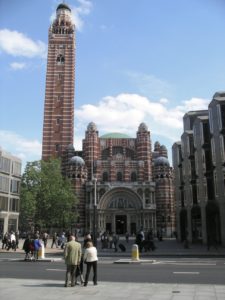Stanford’s Missing Masses
 I recently watched an archived streamed talk by Patrick Russill on Sir Richard Terry and the music that he commissioned for Westminster Cathedral during 1912 to 1919, when he was Music Director there. This was in a series of talks presented by the Royal School of Church Music in their Luncheon talks series and was originally given in February 2021 (It is now available on YouTube HERE).
I recently watched an archived streamed talk by Patrick Russill on Sir Richard Terry and the music that he commissioned for Westminster Cathedral during 1912 to 1919, when he was Music Director there. This was in a series of talks presented by the Royal School of Church Music in their Luncheon talks series and was originally given in February 2021 (It is now available on YouTube HERE).
Terry spent several years studying music at both Oxford and Cambridge Universities although he never obtained a degree from either University. During his time at Cambridge he was a choral scholar in the choir of King’s College Chapel. While in Cambridge he also got to know Stanford. He developed an interest in the music of the Tudor period and the composers associated with the English Reformation. In 1895 he converted to Roman Catholicism and was subsequently asked by Cardinal Vaughan to form and direct the choir at the new Westminster Cathedral in London.
During his time at Westminster Cathedral Terry focused on a repertoire including Gregorian Chant and polyphonic music. He also commissioned a number of the leading composers of the time to compose settings of the Latin Mass and anthems in Latin for his choir.
The music composed to these commissions from Howells, Holst, Charles Wood and Vaughan Williams has largely survived. Sadly, works by C.H Lloyd, Percy Buck, George Oldroyd, William Browne , Stanford and several other composers has not.
Stanford appears to have written three works for Terry. These are the Op. 169, Mass in D minor, the Op. 176 Mass, and a further unaccompanied Mass for 8 voices that was apparently sung at Westminster Cathedral on April 4th, 1920 (Easter Day).
Howells was the most prolific composer of music for Terry and several of his compositions for Westminster Cathedral survive. Two months after his talk Patrick Russill received a parcel from Australia which included Howells’ autographed score of a 1914 Nunc Dimittis written for Westminster Cathedral. This is in now in the library of the Royal College of Music.
Given the success and popularity of Stanford’s church music it is somewhat surprising that Stanford’s three compositions for Terry and Westminster Cathedral appear to have disappeared without trace. We can only hope that one day the autograph manuscripts will resurface, and that we will then be able hear this music performed by the Choir for which it was composed.
